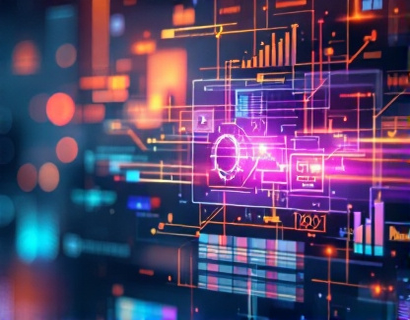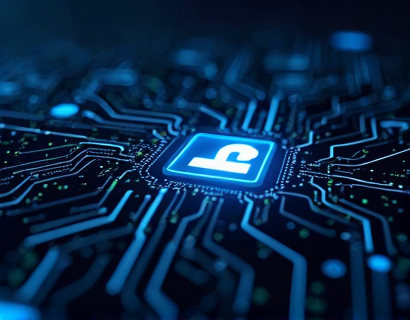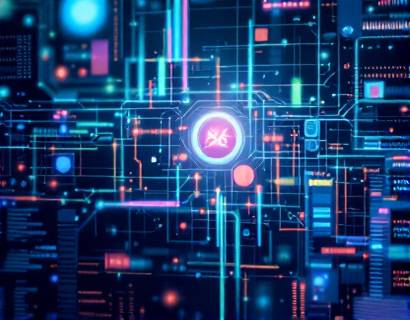The Synergy of Crypto and AI: Revolutionizing Digital Engagement
The intersection of blockchain technology and artificial intelligence (AI) is giving rise to a new era of digital engagement, characterized by enhanced security, personalization, and interactivity. This synergy is not just a technological curiosity but a transformative force that is reshaping how users interact with digital platforms and services. For tech enthusiasts and professionals, understanding this convergence is crucial, as it holds the key to unlocking more sophisticated and user-centric applications.
The foundation of this synergy lies in the unique properties of blockchain and AI. Blockchain, with its decentralized and immutable ledger, provides a secure and transparent environment for transactions and data storage. AI, on the other hand, excels in processing vast amounts of data to uncover patterns, make predictions, and automate complex tasks. When combined, these technologies can create systems that are not only secure and reliable but also highly adaptive and personalized.
Enhanced Security Through Blockchain and AI
One of the most significant benefits of integrating blockchain and AI is the enhancement of security measures. Blockchain's inherent security features, such as cryptographic hashing and consensus mechanisms, ensure that data is tamper-proof and transparent. AI can further bolster these security measures by detecting and mitigating threats in real-time. Machine learning algorithms can analyze patterns in transaction data to identify anomalies and potential fraud, allowing for proactive security responses.
For instance, AI-driven security systems can monitor blockchain networks for unusual activity, such as sudden spikes in transaction volume or unexpected access patterns. These systems can automatically trigger alerts and implement countermeasures, such as temporary locks on suspicious accounts, to prevent breaches. This combination of blockchain's immutability and AI's predictive capabilities creates a robust defense against cyber threats, ensuring that user data and assets remain protected.
Personalized User Experiences
Personalization is a key driver of user engagement in the digital space. AI algorithms can analyze user behavior, preferences, and interactions to deliver tailored content and services. When integrated with blockchain, this personalization can be taken to new heights. Blockchain ensures that user data is securely stored and managed, giving users greater control over their information while maintaining privacy.
Smart contracts, self-executing contracts with the terms directly written into code, can automate personalized experiences. For example, a user's preferences and consent can be encoded into a smart contract, ensuring that only relevant and approved content is delivered. This not only enhances the user experience but also builds trust, as users know their data is handled transparently and securely.
Content Recommendation Systems
Content recommendation systems are a prime example of AI-driven personalization. These systems use machine learning to analyze user interactions, such as clicks, views, and shares, to suggest relevant content. By integrating blockchain, these systems can ensure that the data used for recommendations is tamper-proof and that users have sovereignty over their data. This combination results in more accurate and trustworthy recommendations, keeping users engaged for longer periods.
Moreover, blockchain can facilitate decentralized content creation and distribution, allowing creators to monetize their work directly through tokenized rewards. AI can optimize the distribution of these rewards based on user engagement metrics, ensuring that creators are incentivized to produce high-quality content that resonates with their audience.
Interactive and Immersive Experiences
The synergy of blockchain and AI is also transforming the way users interact with digital platforms, making experiences more immersive and interactive. Virtual reality (VR) and augmented reality (AR) technologies, when combined with blockchain and AI, can create unique and secure environments for users to explore and engage with digital content.
Blockchain can ensure the authenticity and ownership of digital assets within these environments, such as virtual items or real estate. AI can enhance these experiences by providing dynamic and responsive interactions. For example, AI-powered NFTs (non-fungible tokens) can have unique properties and behaviors, making each digital asset distinct and valuable. Smart contracts can automate transactions and interactions within these virtual spaces, ensuring smooth and secure user experiences.
Decentralized Gaming
Decentralized gaming is a fascinating application of this synergy. In traditional gaming, user data and assets are often controlled by central authorities, leading to issues like data breaches and unfair practices. Blockchain and AI can create decentralized gaming platforms where users own their in-game assets and have full control over their data. AI can enhance gameplay by creating adaptive challenges and personalized narratives, making each gaming session unique and engaging.
For instance, AI can analyze a player's skills and preferences to adjust the difficulty level and storyline in real-time. Blockchain ensures that player achievements and assets are securely stored and can be transferred between games or platforms, fostering a more open and collaborative gaming ecosystem.
Optimized User Engagement Through Data Analytics
Data analytics plays a crucial role in optimizing user engagement, and the combination of blockchain and AI takes this to a new level. AI can process and analyze large datasets to identify trends, preferences, and behaviors, providing insights that can be used to improve user experiences. Blockchain ensures that these datasets are secure and that user consent is respected.
Blockchain-based data marketplaces can enable users to monetize their data while maintaining control over its usage. AI algorithms can analyze the data provided by users to offer personalized services and content, creating a win-win situation. This approach not only enhances user engagement but also fosters a more transparent and ethical data ecosystem.
Predictive Analytics for User Retention
Predictive analytics, powered by AI, can forecast user behavior and churn, allowing platforms to proactively retain users. By integrating blockchain, these analytics can be based on verifiable and secure data, ensuring that user consent and privacy are upheld. For example, AI can identify users at risk of leaving a platform and trigger personalized retention strategies, such as exclusive offers or enhanced features.
Blockchain can facilitate the implementation of these strategies by ensuring that rewards and incentives are securely and transparently delivered. This combination of predictive analytics and blockchain-driven incentives can significantly improve user retention rates, leading to more engaged and loyal user bases.
Challenges and Considerations
While the synergy of blockchain and AI offers numerous benefits, there are also challenges and considerations that need to be addressed. One of the primary challenges is the technical complexity involved in integrating these technologies. Developers must have a deep understanding of both blockchain and AI to create seamless and effective solutions.
Another consideration is the regulatory landscape. As blockchain and AI continue to evolve, regulations are still catching up. Ensuring compliance with data protection laws, such as GDPR, is essential to avoid legal issues and maintain user trust. Transparency and ethical practices should be at the forefront of any implementation.
Scalability and Performance
Scalability is a critical factor for widespread adoption. Blockchain networks, particularly those using proof-of-work consensus mechanisms, can face scalability issues due to high transaction costs and slow processing times. AI can help optimize blockchain performance by predicting network congestion and dynamically adjusting resource allocation. However, further research and development are needed to create blockchain solutions that can handle large-scale, real-time applications.
Interoperability between different blockchain platforms and AI systems is another challenge. Standardization and open protocols can facilitate seamless integration, enabling a more cohesive and efficient ecosystem. Collaboration among developers and organizations is essential to overcome these hurdles and unlock the full potential of blockchain and AI synergy.
Future Prospects
The future of blockchain and AI synergy is promising, with ongoing advancements poised to drive even more innovative applications. As technology continues to evolve, we can expect to see more sophisticated and user-centric solutions that leverage the strengths of both blockchain and AI.
One area of excitement is the development of decentralized AI models, where AI algorithms are trained and run on a blockchain network. This approach can enhance privacy and security, as data remains decentralized and users have more control over their contributions. Additionally, the rise of edge computing, combined with blockchain and AI, can lead to faster and more efficient data processing, reducing latency and improving user experiences.
Another promising direction is the integration of blockchain and AI in the Internet of Things (IoT). Smart devices can generate vast amounts of data, which can be securely and efficiently processed using AI to provide actionable insights. Blockchain can ensure the integrity and privacy of this data, creating a robust and trustworthy IoT ecosystem.
Conclusion
The synergy between blockchain and AI is transforming digital engagement by creating more secure, personalized, and interactive experiences. For tech enthusiasts and professionals, understanding this convergence is essential for staying ahead in the rapidly evolving tech landscape. As these technologies continue to mature, we can expect to see even more innovative applications that redefine how we interact with the digital world.










































